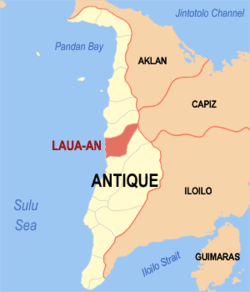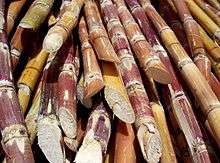Laua-an, Antique
| Laua-an | |
|---|---|
| Municipality | |
 Location within Antique province | |
.svg.png) Laua-an Location within the Philippines | |
| Coordinates: 11°09′N 122°03′E / 11.15°N 122.05°ECoordinates: 11°09′N 122°03′E / 11.15°N 122.05°E | |
| Country | Philippines |
| Region | Western Visayas (Region VI) |
| Province | Antique |
| District | Lone district |
| Founded | January 1, 1915 |
| Barangays | 40 (see Barangays) |
| Government [1] | |
| • Type | Sangguniang Bayan |
| • Mayor | Francisco G. Baladjay Jr. |
| Area[2] | |
| • Total | 100.72 km2 (38.89 sq mi) |
| Population (2015 census)[3] | |
| • Total | 26,072 |
| • Density | 260/km2 (670/sq mi) |
| • Voter (2016)[4] | 16,835 |
| Time zone | PST (UTC+8) |
| ZIP code | 5705 |
| IDD : area code | +63 (0)36 |
| Income class | 4th class |
| PSGC | 060609000 |
| Website |
elgu |
Laua-an, officially the Municipality of Laua-an (Karay-a: Banwa kang Laua-an; Hiligaynon: Banwa sang Laua-an; Filipino: Bayan ng Laua-an), is a municipality in the province of Antique in the Western Visayas (Region VI) of the Philippines. The population was 26,072 at the 2015 census.[3] In the 2016 election, it had 16,835 registered voters.[4]
Laua-an celebrates its Pahinis Festival every January.
Geography
Laua-an is located at 11°09′N 122°03′E / 11.15°N 122.05°E.
According to the Philippine Statistics Authority, the municipality has a land area of 100.72 square kilometres (38.89 sq mi)[2] constituting 3.69% of the 2,729.17-square-kilometre- (1,053.74 sq mi) total area of Antique.
Barangays
Laua-an is politically subdivided into 40 barangays.[5]
| PSGC | Barangay | Population | ±% p.a. | ||
|---|---|---|---|---|---|
| 2015[3] | 2010[6] | ||||
| 060609043 | Bagongbayan | 2.7% | 706 | 659 | +1.32% |
| 060609002 | Banban | 0.6% | 147 | 129 | +2.52% |
| 060609003 | Bongbongan | 1.0% | 250 | 265 | −1.10% |
| 060609004 | Cabariwan | 2.5% | 660 | 620 | +1.20% |
| 060609005 | Cadajug | 4.4% | 1,153 | 1,110 | +0.73% |
| 060609006 | Canituan | 2.2% | 568 | 572 | −0.13% |
| 060609007 | Capnayan | 1.4% | 365 | 319 | +2.60% |
| 060609008 | Casit-an | 4.6% | 1,200 | 1,157 | +0.70% |
| 060609010 | Guiamon | 1.0% | 249 | 239 | +0.78% |
| 060609009 | Guinbanga-an | 7.2% | 1,879 | 1,864 | +0.15% |
| 060609011 | Guisijan | 9.2% | 2,404 | 2,382 | +0.18% |
| 060609012 | Igtadiao | 1.1% | 294 | 262 | +2.22% |
| 060609013 | Intao | 2.5% | 660 | 672 | −0.34% |
| 060609014 | Jaguikican | 3.4% | 874 | 896 | −0.47% |
| 060609015 | Jinalinan | 0.8% | 202 | 220 | −1.61% |
| 060609016 | Lactudan | 0.9% | 247 | 274 | −1.96% |
| 060609017 | Latazon | 1.8% | 476 | 494 | −0.70% |
| 060609018 | Laua-an | 1.5% | 379 | 349 | +1.58% |
| 060609020 | Liberato | 1.6% | 411 | 463 | −2.24% |
| 060609021 | Lindero | 6.3% | 1,649 | 1,560 | +1.06% |
| 060609022 | Liya-liya | 1.6% | 422 | 395 | +1.27% |
| 060609019 | Loon | 2.8% | 743 | 735 | +0.21% |
| 060609023 | Lugta | 2.8% | 719 | 576 | +4.31% |
| 060609024 | Lupa-an | 2.1% | 559 | 557 | +0.07% |
| 060609025 | Magyapo | 1.0% | 257 | 242 | +1.15% |
| 060609026 | Maria | 5.0% | 1,311 | 1,364 | −0.75% |
| 060609027 | Mauno | 2.0% | 524 | 457 | +2.64% |
| 060609028 | Maybunga | 2.0% | 525 | 343 | +8.44% |
| 060609029 | Necesito (Paniatan) | 1.2% | 307 | 339 | −1.87% |
| 060609030 | Oloc | 4.5% | 1,168 | 994 | +3.12% |
| 060609031 | Omlot | 1.0% | 260 | 233 | +2.11% |
| 060609032 | Pandanan | 1.4% | 359 | 346 | +0.70% |
| 060609034 | Paningayan | 1.5% | 384 | 360 | +1.24% |
| 060609035 | Pascuala | 0.7% | 194 | 202 | −0.77% |
| 060609036 | Poblacion (Centro) | 7.6% | 1,975 | 1,933 | +0.41% |
| 060609038 | San Ramon | 0.6% | 167 | 139 | +3.56% |
| 060609039 | Santiago | 2.6% | 670 | 622 | +1.43% |
| 060609040 | Tibacan | 0.7% | 177 | 230 | −4.86% |
| 060609041 | Tigunhao | 1.3% | 343 | 375 | −1.68% |
| 060609042 | Virginia | 0.9% | 235 | 263 | −2.12% |
| Total | 26,072 | 25,211 | +0.64% | ||
Demographics
| Population census of Laua-an | |||||||||||||||||||||||||
|---|---|---|---|---|---|---|---|---|---|---|---|---|---|---|---|---|---|---|---|---|---|---|---|---|---|
|
| ||||||||||||||||||||||||
| Source: PSA[3][6][7] | |||||||||||||||||||||||||
In the 2015 census, Laua-an had a population of 26,072.[3] The population density was 260 inhabitants per square kilometre (670/sq mi).
In the 2016 election, it had 16,835 registered voters.[4]
Economy
The town is primarily agricultural with rice, sugarcane and corn as primary crops. Monggo beans, peanuts and vegetables are also grown in limited areas of the land. Laua-an has the most number of sugarcane mills in the whole province of Antique. Some sugarcane mills in town refines muscovado sugar through technology transfer from foreign aid such that residue-free muscovado sugar is now produced.
The deep sea waters of Sulu Sea is abundant with fish and marine life like sardines, tuna, squids, mackerel, crabs and other seafoods which is a source of living for most residents.
Tourism
Among the tourist attractions are Mount Igmatongtong in barangay Capnayan, Maybunga Water falls in barangay Maybunga, and Estaka Hill in barangay Poblacion. Estaca Hill in the Poblacion provides a strategic place to view the barangay Poblacion, the Sulu Sea and its environs.
Festivals

Pre-Catholic pre-Spanish Indianized Srivijaya-era Pahinis Festival similar to Makar Sankranti, is celebrated annually to feature the muscovado sugar industry of the town, the technology of which dates back to the Spanish era. "Pahinis" means to clean and prepare the tools for sugarcane milling which corresponds to a celebration to thank God for a fine harvest of sugarcane.
The town celebrates its centennial foundation in January 2015. Weeklong celebration features Pahinis Festival Mardi Gras; LGU, professionals, senior citizens and barangay night; Bugal Kang Laua-an (Pride of Laua-an) Awards Night; and Search for Hara de Pahinis (Pahinis Queen) Beauty Pageant and Coronation Night. The winner of this pageant represents the municipality during the Search for Lin-ay kang Antique (Miss Antique) during the Binirayan Festival in the capital town of San Jose de Buenavista every last week of December. Other events include boat racing along the Sulu Sea, and Aring Beach Festival at the last night of the celebration in Barangay Cadajug.
References
- ↑ "Municipality". Quezon City, Philippines: Department of the Interior and Local Government. Retrieved 31 May 2013.
- 1 2 "Province: Antique". PSGC Interactive. Makati City, Philippines: Philippine Statistics Authority. Retrieved 3 November 2016.
- 1 2 3 4 5 "Region VI (WESTERN VISAYAS)". Census of Population (2015): Total Population by Province, City, Municipality and Barangay (Report). PSA. Retrieved 20 June 2016.
- 1 2 3 "2016 National and Local Elections Statistics". Commission on Elections. 2016.
- ↑ "Municipal: Laua-an, Antique". PSGC Interactive. Quezon City, Philippines: Philippine Statistics Authority. Retrieved 8 January 2016.
- 1 2 "Region VI (WESTERN VISAYAS)". Census of Population and Housing (2010): Total Population by Province, City, Municipality and Barangay (Report). NSO. Retrieved 29 June 2016.
- ↑ "Region VI (WESTERN VISAYAS)". Census of Population (1995, 2000 and 2007): Total Population by Province, City and Municipality (Report). NSO. Archived from the original on 24 June 2011.
 |
Barbaza | Jamindan, Capiz |  | |
| Sulu Sea | |
Bugasong | ||
| ||||
| | ||||
| Bugasong |